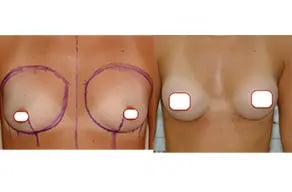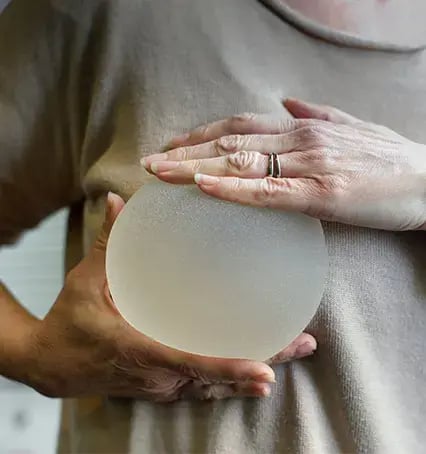Breast Augmentation
Breast Augmentation
- What is Breast Augmentation?
- Breast Augmentation Pros and Cons
- How Much Does Breast Augmentation Cost?
- How to Prepare for Breast Augmentation Surgery
- How Breast Augmentation is Performed
- What to Expect During Recovery
- Risks and Side Effects of Breast Augmentation
- When Will You See the Results?
- How Long Does Breast Augmentation Last?
- Can You Still Breastfeed After a Breast Augmentation?

&Quick Facts
-
Satisfaction 94%
-
 Reviews 60
Reviews 60 -
 Average Cost $ 4000
Average Cost $ 4000 -
 Related Doctors 7
Related Doctors 7 -
 Treatment General Anesthesia
Treatment General Anesthesia -
 Recovery Time 2-3 Weeks
Recovery Time 2-3 Weeks -
 Question&Answer 7
Question&Answer 7

It is the result of rhinoplasty performed by Hakan Ocsel, MD. For reference purposes only, results may vary.
&Doctors
Most Active Doctors on NewMe
&Real Reviews
Most Popular Reviews
&Real Reviews
Real Reviews Q&A




&All About Understanding Breast Augmentation: The Essentials of a Boob Job
&All About Breast Augmentation
What is Breast Augmentation?
Breast augmentation, also known as a "boob job," is a surgery to make breasts bigger or improve their shape. It's the most common cosmetic surgery in the world.
Many women get it to restore lost volume from aging, weight loss, pregnancy, or breastfeeding. The procedure usually uses breast implants filled with silicone gel or saline (saltwater).
Implants are placed through incisions around the nipples, under the breasts, or in the armpits. Another method uses fat from other body parts to enhance the breasts.
If sagging is an issue, a breast lift can be done with implants for a perkier look.

Breast Augmentation Pros and Cons
- High satisfaction: 95% of people say it's worth it.
- Breasts look larger, fuller, and more youthful, boosting self-confidence.
- Customizable implants in size and shape.
- Fat transfer uses your tissue for natural results.
- Implants can last over 10 years; fat transfer results are permanent.
- Changes in weight or hormones can affect results.
- Fat transfer can’t give as dramatic a change as implants.
- Fat transfer results can be unpredictable.
- Risks include lumps, asymmetry, and implant issues like a rupture.
- Implants may need replacing over time.
- Possible health issues, including rare cancers, with implants.
Our mission is to create a world where every investment in modern beauty is Worth It.
Let's keep in touch
Get updates of the treatments you are interested
How Much Does Breast Augmentation Cost?
In the US, breast augmentation costs about $6,675. In Turkey, it starts at $3,500, and in the UK, it starts at £5,000.
Several factors can affect the price:
- The type of augmentation and surgical technique.
- The type of implant you choose.
- Your surgeon’s experience level.
- Where the surgery is done.
- Who gives you anesthesia.
Costs can vary, so it's important to talk with your surgeon to get an accurate estimate for your specific case.
How to Prepare for Breast Augmentation Surgery
Start by consulting with one or more plastic surgeons. Choose a board-certified surgeon who specializes in breast surgery for the safest experience.
During your consultation, the surgeon will examine your chest and breasts, make recommendations, discuss the risks, and explain the recovery process.
If you're over 50, a pre-surgery mammogram might be needed.
For breast implants, the surgeon will help you choose the best size, type, incision location, and placement.
Many surgeons use 3D imaging to show possible results, or have you try on different implant sizes to see how they feel and look.

How Breast Augmentation is Performed
Breast Implant Surgery
- Done under local or general anesthesia.
- Incisions are made around the nipple, under the breast, or in the armpit.
- Implants are placed above or below chest muscles.
- Incisions are closed with stitches or adhesive.
- The procedure takes about an hour and doesn't need an overnight stay.
Fat Transfer Breast Augmentation
- Fat is removed from the belly or thighs through liposuction.
- The fat is purified and injected into the breasts.
- Typically increases breast size by one cup.
Breast Lift Surgery
- Incisions are made around the nipple, down to the breast crease.
- Excess skin is removed, and breast tissue is lifted and reshaped.
- Implants or fat transfer can be added for volume.
- Nipples are repositioned but not detached, and areolas can be resized.
What to Expect During Recovery
After breast augmentation, most people need about a week to recover. Here's what to expect:
- Your incision will have dressings. You'll get instructions on how to change and clean them to prevent infection.
- You'll wear a sports bra all day and night for the first week, except when showering, to support and reduce swelling.
- If you have drainage tubes, they'll stay in place for up to two weeks.
- Most people return to work in a week but avoid sex for two weeks and heavy activities for four weeks.
- Sleep on your back for about six weeks to keep the implants in shape.
Risks and Side Effects of Breast Augmentation
Breast implants come with risks. Your surgeon should explain these:
- Implant leakage or rupture
- Fluid buildup (seroma)
- Painful scar tissue around the implant (capsular contracture)
- Skin wrinkling or rippling
- Rare cancer linked to some implants (BIA-ALCL)
- Breast implant illness (BII), with symptoms like fatigue and joint pain
Breast fat transfer also has risks, including:
- Cysts
- Infection
- Hard lumps (microcalcifications)
- Death of fat cells (necrosis)
Fat transfer might interfere with mammograms, making cancer detection harder. Your surgeon will discuss how to handle these risks.
Our mission is to create a world where every investment in modern beauty is Worth It.
Let's keep in touch
Get updates of the treatments you are interested
When Will You See the Results?
After getting breast implants, your breasts will look high at first. They will start to "drop and fluff" into a natural position over time. This process begins at six weeks, and by three months, they are about 80% settled.
With a fat transfer, you’ll see more volume right away, but some fat will be absorbed in the first three months. By six months, most swelling will be gone, and your results will be clear. In a year, the new fat will act like natural breast tissue.

How Long Does Breast Augmentation Last?
Breast implants usually last at least 10 years, and sometimes much longer. Many people think implants need replacing every 10 years, but that’s not always true. According to the FDA, about 1 in 5 women need revision surgery within 10 years due to issues like leaks or hardening.
If you don’t have complications, modern implants can last 20 years or more. Fat transfer results can last even longer, but your breasts will still age and change with your body. Some people choose revision surgery after about 10 years as their skin sags and changes.
Can You Still Breastfeed After a Breast Augmentation?
Yes, you can usually still breastfeed with implants. However, any breast surgery, especially if the incision is around the nipple, might damage milk ducts and reduce milk production.
Fat transfer breast augmentation is less likely to affect breastfeeding, as long as you don't have nipple surgery at the same time. Studies show that while there is a risk, many women with implants successfully breastfeed without issues.
What is Breast Augmentation?
Breast augmentation, also known as a "boob job," is a surgery to make breasts bigger or improve their shape. It's the most common cosmetic surgery in the world.
Many women get it to restore lost volume from aging, weight loss, pregnancy, or breastfeeding. The procedure usually uses breast implants filled with silicone gel or saline (saltwater).
Implants are placed through incisions around the nipples, under the breasts, or in the armpits. Another method uses fat from other body parts to enhance the breasts.
If sagging is an issue, a breast lift can be done with implants for a perkier look.

Breast Augmentation Pros and Cons
- High satisfaction: 95% of people say it's worth it.
- Breasts look larger, fuller, and more youthful, boosting self-confidence.
- Customizable implants in size and shape.
- Fat transfer uses your tissue for natural results.
- Implants can last over 10 years; fat transfer results are permanent.
- Changes in weight or hormones can affect results.
- Fat transfer can’t give as dramatic a change as implants.
- Fat transfer results can be unpredictable.
- Risks include lumps, asymmetry, and implant issues like a rupture.
- Implants may need replacing over time.
- Possible health issues, including rare cancers, with implants.
Our mission is to create a world where every investment in modern beauty is Worth It.
Let's keep in touch
Get updates of the treatments you are interested
How Much Does Breast Augmentation Cost?
In the US, breast augmentation costs about $6,675. In Turkey, it starts at $3,500, and in the UK, it starts at £5,000.
Several factors can affect the price:
- The type of augmentation and surgical technique.
- The type of implant you choose.
- Your surgeon’s experience level.
- Where the surgery is done.
- Who gives you anesthesia.
Costs can vary, so it's important to talk with your surgeon to get an accurate estimate for your specific case.
How to Prepare for Breast Augmentation Surgery
Start by consulting with one or more plastic surgeons. Choose a board-certified surgeon who specializes in breast surgery for the safest experience.
During your consultation, the surgeon will examine your chest and breasts, make recommendations, discuss the risks, and explain the recovery process.
If you're over 50, a pre-surgery mammogram might be needed.
For breast implants, the surgeon will help you choose the best size, type, incision location, and placement.
Many surgeons use 3D imaging to show possible results, or have you try on different implant sizes to see how they feel and look.

How Breast Augmentation is Performed
Breast Implant Surgery
- Done under local or general anesthesia.
- Incisions are made around the nipple, under the breast, or in the armpit.
- Implants are placed above or below chest muscles.
- Incisions are closed with stitches or adhesive.
- The procedure takes about an hour and doesn't need an overnight stay.
Fat Transfer Breast Augmentation
- Fat is removed from the belly or thighs through liposuction.
- The fat is purified and injected into the breasts.
- Typically increases breast size by one cup.
Breast Lift Surgery
- Incisions are made around the nipple, down to the breast crease.
- Excess skin is removed, and breast tissue is lifted and reshaped.
- Implants or fat transfer can be added for volume.
- Nipples are repositioned but not detached, and areolas can be resized.
What to Expect During Recovery
After breast augmentation, most people need about a week to recover. Here's what to expect:
- Your incision will have dressings. You'll get instructions on how to change and clean them to prevent infection.
- You'll wear a sports bra all day and night for the first week, except when showering, to support and reduce swelling.
- If you have drainage tubes, they'll stay in place for up to two weeks.
- Most people return to work in a week but avoid sex for two weeks and heavy activities for four weeks.
- Sleep on your back for about six weeks to keep the implants in shape.
Risks and Side Effects of Breast Augmentation
Breast implants come with risks. Your surgeon should explain these:
- Implant leakage or rupture
- Fluid buildup (seroma)
- Painful scar tissue around the implant (capsular contracture)
- Skin wrinkling or rippling
- Rare cancer linked to some implants (BIA-ALCL)
- Breast implant illness (BII), with symptoms like fatigue and joint pain
Breast fat transfer also has risks, including:
- Cysts
- Infection
- Hard lumps (microcalcifications)
- Death of fat cells (necrosis)
Fat transfer might interfere with mammograms, making cancer detection harder. Your surgeon will discuss how to handle these risks.
Our mission is to create a world where every investment in modern beauty is Worth It.
Let's keep in touch
Get updates of the treatments you are interested
When Will You See the Results?
After getting breast implants, your breasts will look high at first. They will start to "drop and fluff" into a natural position over time. This process begins at six weeks, and by three months, they are about 80% settled.
With a fat transfer, you’ll see more volume right away, but some fat will be absorbed in the first three months. By six months, most swelling will be gone, and your results will be clear. In a year, the new fat will act like natural breast tissue.

How Long Does Breast Augmentation Last?
Breast implants usually last at least 10 years, and sometimes much longer. Many people think implants need replacing every 10 years, but that’s not always true. According to the FDA, about 1 in 5 women need revision surgery within 10 years due to issues like leaks or hardening.
If you don’t have complications, modern implants can last 20 years or more. Fat transfer results can last even longer, but your breasts will still age and change with your body. Some people choose revision surgery after about 10 years as their skin sags and changes.
Can You Still Breastfeed After a Breast Augmentation?
Yes, you can usually still breastfeed with implants. However, any breast surgery, especially if the incision is around the nipple, might damage milk ducts and reduce milk production.
Fat transfer breast augmentation is less likely to affect breastfeeding, as long as you don't have nipple surgery at the same time. Studies show that while there is a risk, many women with implants successfully breastfeed without issues.
















